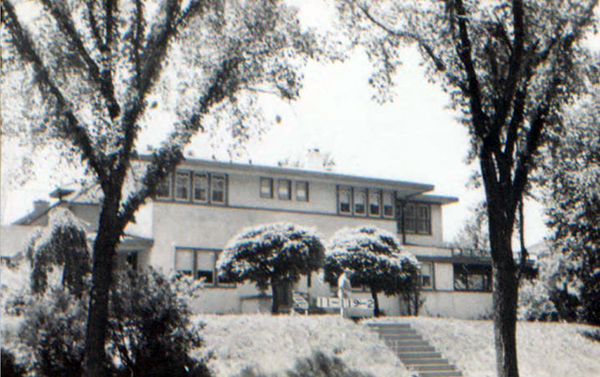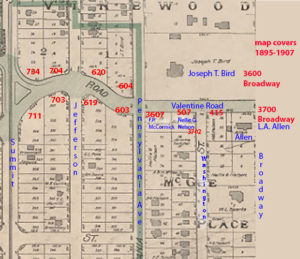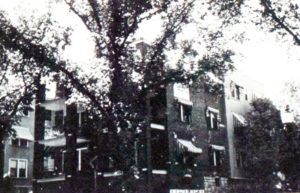
As Midtown was developing, there was tension along Valentine Road east of Summit between developers and those who wanted the area to remain single-family.
Valentine Road between Broadway and Southwest Trafficway has been home to Kansas City pioneers, wealthy widows, churches and modest apartment dwellers. It may also have been home to the first plus-size clothing shop in Kansas City in 1925.
The street was originally called W. 35th Street, a part of the regular Kansas City grid, until it was elevated to a boulevard by the park board in 1906-7.
Its greatest asset – as well as its most notable challenge – might be its location: snaking between Broadway Boulevard and Summit Street (now Southwest Trafficway), the road was a major automobile connector and adjacent to major streetcar lines. That made it attractive to wealthy families looking for homes in the early 1900s, but by the 1920s, the location was being eyed by developers looking for new locations for residential hotels and apartments.
As part of our Uncovering History Project, the Midtown KC Post is taking a look at each block in Midtown, including a set of 1940 tax assessment photos which is available for many blocks. (Many people seem confused by the tax assessment photos, which all include a man holding a sign. Here’s the story behind them). Today, Valentine Road within the Valentine neighborhood, from Broadway Boulevard to Southwest Trafficway.

A recent Google maps aerial image of Valentine Road stretching from Broadway at the Uptown Theater to Southwest Trafficway. A few apartment buildings are scattered in with residential homes, but if developers had had their way in the 1920s, there would have been more.
Before 1910, several large homes clustered at Broadway and Valentine
After the turn of the 20th century, Broadway was an important residential street rather than a commercial corridor. It was lined with large, stately homes, including two at Valentine.

This platte map of the Roanoke district shows Valentine Road between 1895 and 1907. Note that only the two large homes at Broadway had been built by the end of this period.
On the northwest corner stood Elmhurst, the five-acre home of Joseph Bird, one of the investors of the Emery Bird Thayer and Company department store. The sixteen-room mansion was built in 1898 by John Perry, a coal and coke company owner, as a surprise for his wife and children who had gone on a tour of Europe. They never saw the home, however; their ship, the Bourgogne, sank off the coast of Nova Scotia. Bird’s widow, Annie Ridenbaugh Bird, would live there for several decades as the neighborhood around her changed, until her home was razed in 1937 and became the parking lot of the Uptown Theater and later the Uptown Shopping Center. (more about the Bird home in an upcoming post).
Across Valentine on the southwest corner was the L.A. Allen home, built for a famous cattleman. It was later used as a church, a boys’ home and a funeral parlor before being demolished in 1925 to make way for the Uptown Theater.
Another home, also no longer standing, stood at the corner of Valentine and Washington Street just west of the Allen home. It was the home of Frank Purcell in 1910.
Development threatens homes in 1920s
Looking at the 1920 census shows more homes along Valentine Road had been built in the previous decade. Two lots at 703 and 704, for example, were purchased in 1917, and 604 was purchased in 1919. The owners of the lots then hired architects to design their new residences.
Mrs. Bird remained in Elmhurst, although the Allen house had now been converted to institutional use. The first floor had been transformed into a worship space for the Hyde Park Methodist Church and its pastor lived on the second floor. They were still there until 1923, when developers began to see a new potential for the site.
Broadway was undergoing rapid changes. E.J. Willett, a developer who was active on Broadway, announced plans in 1924 for a 12-story office building and motion picture theater on the Allen site. This would become the Uptown Theater building.
The Purcell home, meanwhile, was sold in 1921 to Addie Owen, who ran the Addie Owen Shop selling womens’ clothing at 3607 Broadway. Owen converted the Purcell property into the Addie Owen French Shop – probably the first plus-sized clothing store in Kansas City. According to the Kansas City Star, she was following a trend being seen in larger cities. “It will be the first of its kind in Kansas City – the charmingly intimate type of shop that Chicago and New York women have gone quite mad over. The shop will be devoted exclusively to matron sizes in apparel, both ready made and to order. One may wander from room to room over the entire 2-story residence, for every room holds its revelations in hats, gowns, negligees or wraps.”
But that same year, Owen also sought permission from the city to tear down the house and build a ten-story apartment building on the site. The city denied permission, but developers were clearly eying Valentine Road as ripe for replacing single-family homes with the type of residential hotels being built along Armour Boulevard and across midtown in this decade. A hotel operator bought 604 Valentine in 1921, although the house still stands there today.
Across Summit Street (Southwest Trafficway), the property owners in the Roanoke neighborhood were concerned. The original Roanoke deeds had restricted land usage to single-family homes, but those restrictions expired in 1922. Roanoke watched as business buildings, apartments and boarding houses replaced fine homes in other areas of Midtown. That same year, more than a million dollars of apartment construction was set to begin on Summit Street between Valentine and 38th. The Roanoke owners banded together and bought the all four corners of Valentine and Summit as well as other homes along Valentine in Roanoke to prevent commercial development.
The 1930s and beyond
The rest of the history of the road is consistent with Midtown history in general. Many homes, including the large ones on Valentine east of Summit, were broken up into boarding houses.

This home at the northeast corner of Valentine and Southwest Trafficway was used for a while as a church.
Several were turned to institutional uses, such as stone castle-like house at the corner of Valentine and Pennsylvania which is now The Writer’s Place. It became a church in 1954. The home at 734 Valentine became the Church of God- New Testament Judaism in 1970, with 25-30 members tied to a church in Georgia made up of gentiles who embraced Judaism.
However, the well-built homes along this section of Valentine attracted “urban pioneers” in the 1970s and 1980s, and most of the homes were converted back to their original single-family purposes.
Some of the photos from the 1940 collection are missing. The slideshow below shows those that are available.
[slideshow_deploy id=’26570′]
Historic photos courtesy Kansas City Public Library/Missouri Valley Special Collections.
Do you have memories or more details about this area of Midtown? Please share them with our readers. Would you like us to focus on your block next week? Send us an email.
Our book, Kansas City’s Historic Midtown Neighborhoods, is available now at local bookstores and on Amazon.com. Let us know if you want us to come to your neighborhood association or organization’s meeting to share what we’ve learned about Midtown neighborhood history and tell your members how they can help preserve Midtown history.




Not mentioned is the race track origin of that arced path Valentine takes.